Office Paper Waste
Everything you need to know
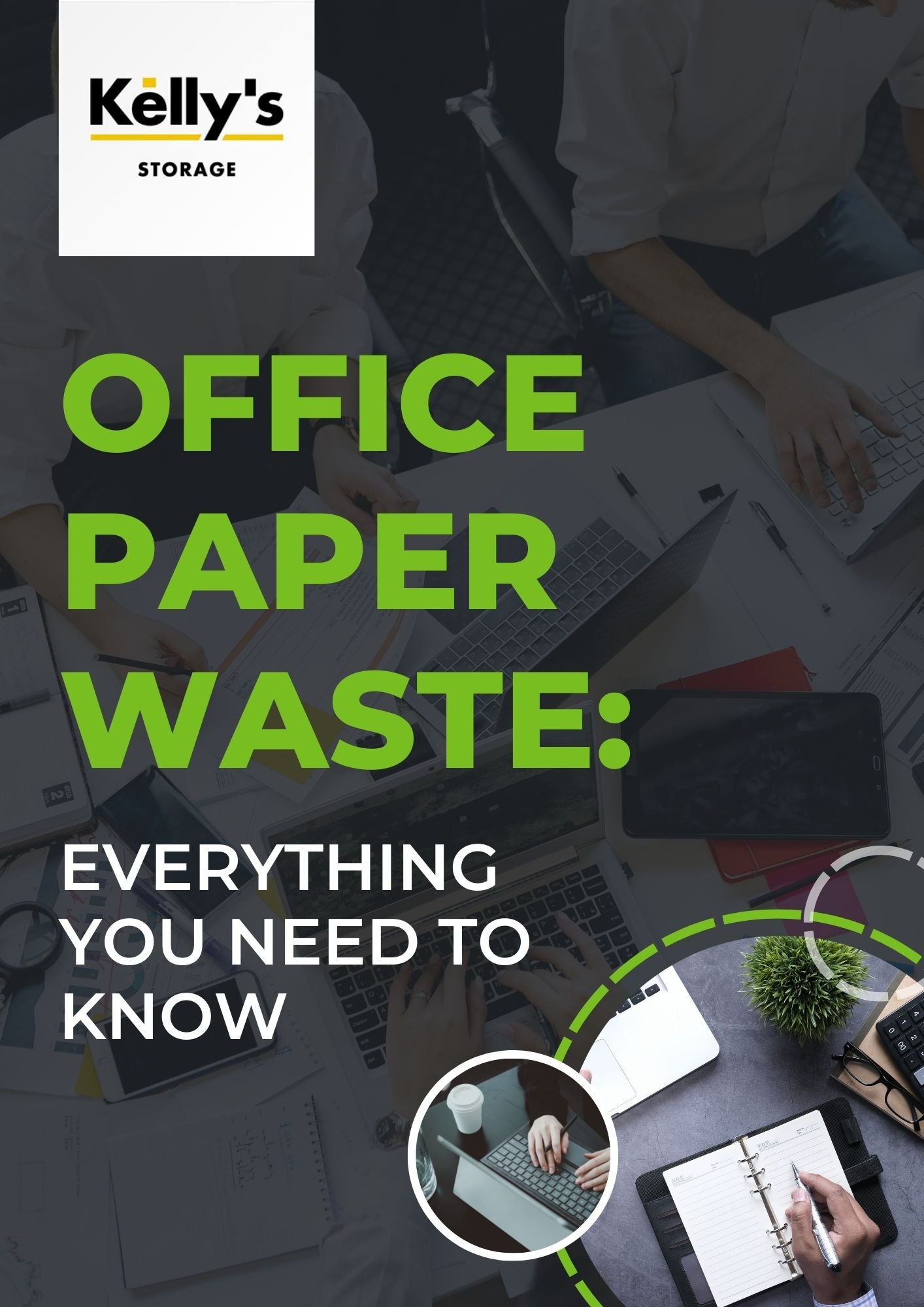
Free eBook: Office paper waste
Download a copy of our eBook to discover how to reduce paper waste in your office
In this modern age of technology, we are lucky enough to have a range of tools and gadgets such as mobile phones, cloud storage and wireless scanners to assist us with our jobs and businesses. Although we don’t rely on paper as much as we used to in the years before, it remains a useful tool in our arsenal of office equipment.
However, have you ever stopped to think about how much paper is wasted in offices each year in the UK? And what the impact of this is?
Read on as we explore the current state of paper waste in offices, the environmental and business implications of this, as well as some useful tips on how you can reduce paper waste in your business.
How much paper is wasted in offices

Office workers across the country often take for granted the amount of paper that they use on a daily basis. From lists and memos to emails and reports, it's easy to go through reams of paper in a single day. The average office worker uses up to a staggering 10,000 sheets of paper every year, which adds up to a whopping 700 million tons of paper used in offices across the country each year. If that wasn't enough to make you think twice about using paper, consider this: the average office worker also produces 4.5 pounds of paper waste each day. That's a total of 1,600 pounds of paper waste per year per person! To put all this into perspective, that is the equivalent of two by fours or 200 reams of paper. With such large numbers, it's no wonder that paper waste is one of the biggest environmental concerns we face today. In addition to the environmental concerns, office paper waste also takes a toll on businesses in terms of time and money. Employees spend valuable hours sorting and shredding documents, and companies must pay to have this waste removed from their premises. But, there is good news and that is there are many ways that can help reduce office paper waste. Encouraging employees to use both sides of a sheet of paper, investing in recycled paper products, and utilising effective records management solutions such as document scanning are all effective strategies for reducing this type of waste.
Have you ever wondered about the amount of office paper waste your company creates each year? Probably not, because most people don't think about it until they're confronted with the numbers. Well, we've compiled a few statistics on office paper waste that might make you think twice the next time you print out something unnecessarily.

Unused Paper
The recycling of paper has become an increasingly important strategy over the last decade. With the rise in electronic communication, there has been a corresponding decrease in the use of paper. However, despite this trend, a significant amount of paper is still wasted each year. A recent study has emphasized the fact that the average office worker uses less than half of the paper that is provided to them. This wasted paper often ends up getting accumulated in landfills, taking up valuable space and releases harmful toxins into the environment. Recycling paper can help to reduce these negative impacts. By recycling used paper, we can save trees, reduce greenhouse gas emissions, and conserve energy. Additionally, recycling helps to create new jobs and stimulate the economy. As more businesses and individuals begin to recycle paper, we can surely make a significant dent in the amount of waste that ends up in landfills each year.
Misprinted Papers
A study done in 2019 shows that the average office worker using misprinted paper can waste up to 10 sheets per day. In a typical workweek, that’s 50 sheets of paper wasted – enough to fill a ream of paper! And in a year, an office worker can waste up to 2,500 sheets of paper – that’s nearly 13 reams of paper!
The study also found out that the vast majority of office workers (86%) don’t think twice about throwing away misprinted paper. In fact, nearly half (48%) said they would rather throw away misprinted paper than recycle it.
These stats are pretty damning, but there is some good news. The study also found that nearly all office workers (96%) are willing to change their printer settings to double-sided or duplex printing in order to help save paper. And nearly two-thirds (64%) said they would be willing to use recycled paper.
So there’s clearly a lot of space for improvement in terms of office workers and their impact on the environment. But with a little bit of effort, we can all help to reduce our paper use and make a positive difference.

Paper meetings
Approximately, only in the United States, the average office worker utilizes 10,000 sheets of copy paper each year, and more than half of that paper is used for printing documents for meetings. That means that the average office worker uses enough paper in one year to cover a football field. If those same workers participated in all their meetings via video conference, they could save nearly 5,000 sheets of paper per year. In addition to the environmental benefits, there would also be significant cost savings. Based on the current price of copy paper, switching to video conferencing for all meetings could save a company more than $9,000 per year. With statistics like these, it's hard to understand why more companies haven't made the switch to video conferencing.
Incomplete Documents
In today's fast-paced business world, time is of the essence. As a result, many office workers find themselves rushing to complete tasks and often overlook important details. This can lead to incomplete documents that are then discarded. Based on a recent study, the average office worker wastes approximately 10 pounds of paper each year due to incomplete documents. That adds up to a total of approximately 2.5 million tons of paper wasted annually in the United States alone. While some of this paper can be recycled, much of it ends up in landfills. In addition to the environmental impact, this wasted paper also represents a lost opportunity cost as businesses could be using this paper for other purposes. To help reduce this waste, office workers should take the time to double-check their work before discarding it. Additionally, businesses should consider investing in recycling programs that can help offset the cost of this wasted paper.
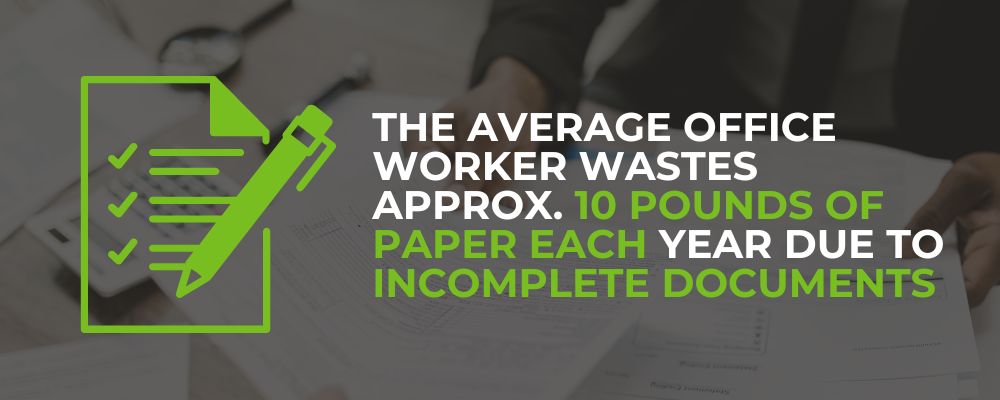
Paper Receipts
In the United States alone, businesses print out an estimated 10 billion paper receipts each year. The vast majority of these receipts end up in the trash, meaning that they quickly become waste. In addition to taking up space in landfills, paper receipts also contribute to deforestation and pollution. It takes roughly 17 trees to produce one ton of paper, and the chemicals used in the production process can pollute waterways. Fortunately, there are many practices that can be adapted to reduce the environmental impact of paper receipts. One option is to switch to electronic receipts, which can be emailed or texted to customers. Another solution is to use recycled paper for receipts, which helps to reduce demand for new trees. By taking steps to reduce paper waste, businesses can help to protect the environment.
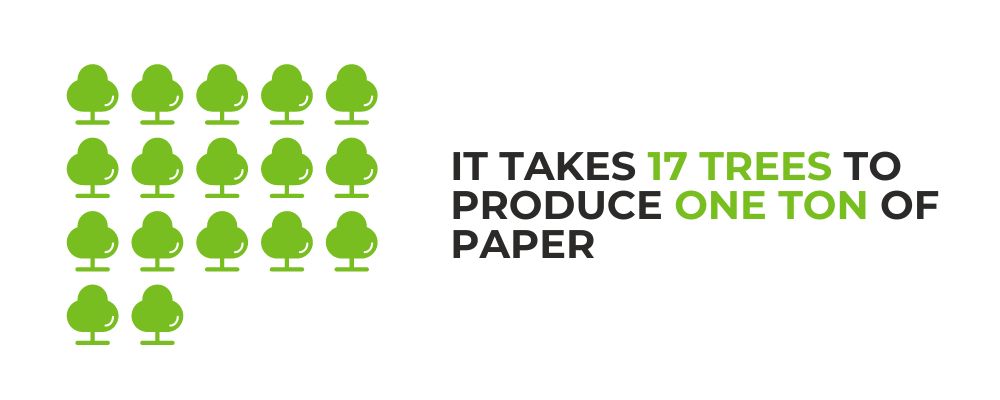
Extraneous Copies Or Backups
Most people don't think twice about making a copy of a paper or printing out an extra copy "just in case." However, all of those extraneous copies add up quickly - and they take their toll on the environment. A study by the Environmental Paper Network found that, on average, each office worker utilize approximately 10,000 sheets of paper each year. And a large percentage of that paper is wasted - either through inappropriate copying or by printing out backups that are never used. In fact, the study found that as much as 30% of all office paper is wasted in this way. That translates to a huge impact on our forests and our climate. The great news is that we can still reduce this waste. For example, we can print on both sides of the paper, make copies only when necessary, and recycle unwanted paper. By taking these small steps, we can make a big difference for the environment.
While the stats on office paper waste are staggering, there are things that businesses can do to reduce their paper footprint. The most effective ways to reduce paper waste is to increase recycling efforts. This means providing employees with easy access to recycling bins and ensuring that all paper waste is properly sorted. Additionally, businesses can also switch to sustainable paper products made from recycled materials. By taking these simple steps, businesses can greatly reduce their paper waste and make a positive and healthy impact on the environment.
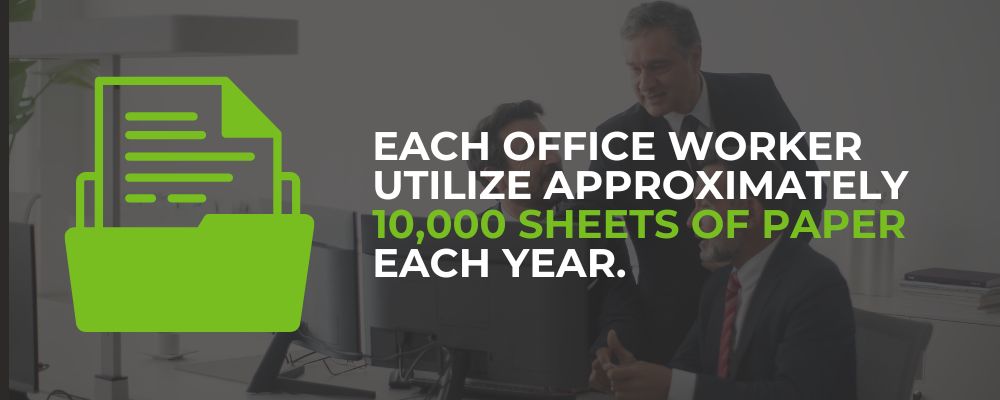
The Environmental Impact Of Paper Waste

Paper waste is one of the most commonly recycled materials, yet it still poses a significant environmental threat. The paper-making process is energy-intensive and uses large amounts of water, which can lead to deforestation and habitat loss. Once paper is produced, it often ends up accumulated in landfills, where it starts to decompose and emits methane, a powerful greenhouse gas. Recycling paper can help to reduce these impacts, but it is not a perfect solution. Recycled paper often contains toxins and chemicals that can leach into soil and water, and the recycling process itself requires substantial amounts of energy. The most sustainable option is to reduce paper consumption altogether. This can be accomplished by switching to digital media, using both sides of paper when possible, and recycling or composting paper products instead of throwing them away.
Think about all of the paper products that you use in a day. Maybe it's the newspaper you read over breakfast, the memo your boss handed to you at work, or the instructions for assembling your new IKEA coffee table. All of those pieces of paper add up quickly and can have a significant environmental impact. In this blog post, we'll take a closer look at just how much of an impact paper waste can have on our environment.
CO2 Emissions
Paper waste is one of the most commonly recycled materials, yet it still poses a significant environmental threat. The paper-making process is energy-intensive and uses large amounts of water, which can lead to deforestation and habitat loss. Recycling paper can help to reduce these impacts, but it is not a perfect solution. Recycled paper often contains toxins and chemicals that can leach into soil and water, and the recycling process itself requires substantial amounts of energy. The most sustainable option is to reduce paper consumption altogether. This can be accomplished by switching to digital media, using both sides of paper when possible, and recycling or composting paper products instead of throwing them away.
Landfills
One of the environmental impacts of paper waste is the strain it places on landfills. Mountains of paper waste can quickly fill up a landfill, leaving less space for other types of waste. In addition, paper decomposes more slowly than other materials, meaning that paper waste can take years to break down completely. As a result, landfills are one of the primary destinations for paper waste. Although recycling paper can help to reduce the amount of paper waste that ends up in landfills, it is not always a sustainable solution. Recycling paper uses large amounts of water and energy, and the recycled paper is often of poor quality. As a result, paper waste continues to be a major environmental issue. One way to reduce the impact of paper waste is to switch to sustainable alternatives, such as digital media or paper made from recycled materials. By making these simple changes, we can help work towards reducing the strain on our landfills and become the positive change our world deserves.
Deforestation
Paper waste has become one of the leading environmental impacts in recent years. Deforestation is the main environmental impact of paper waste, as paper is typically made from trees. In order to make paper, manufacturers cut down trees and use them to create paper products. This process depletes forests, damages ecosystems, and contributes to climate change. Recycling is one way to help reduce the environmental impact of paper waste. Recycling paper allows manufacturers to use less new material, which reduces the amount of trees that need to be cut down. Sustainable paper products are also available, which are made from recycled paper or paper that comes from sustainably managed forests. By reducing the amount of paper waste we create, we can help to protect our environment.
.jpg)
Water Contamination
Paper waste is one of the biggest environmental impacts of paper production. Every year, millions of tons of paper are thrown away, and paper recycling rates are only around 40%. This paper eventually makes its way into landfills, where it decomposes and releases methane, a potent greenhouse gas. Paper production also uses large amounts of water, which can easily become contaminated with chemicals used in the paper-making process. This water contamination can pollute local waterways and harm wildlife. To reduce the environmental impact of paper waste, it is important to recycle paper and use sustainable paper products. Recycling paper helps to reduce the amount of paper waste in landfills, and sustainable paper products are made with fewer harmful chemicals. By making these simple changes, we can help to protect our environment from the negative impacts of paper waste.
Waste of Natural Resources
Most people don't think twice about throwing away a paper coffee cup or paper towel. However, paper waste is a major problem for the environment. Every year, millions of trees are cut down to make paper products, which quickly end up in landfills. In addition, the paper manufacturing process uses large amounts of water and energy, leading to pollution and greenhouse gas emissions. Recycled paper uses far less energy and water than virgin paper, and it doesn't require cutting down trees. As a result, it's a much more sustainable option. By choosing recycled paper products, we can all do our part to reduce the environmental impact of paper waste.
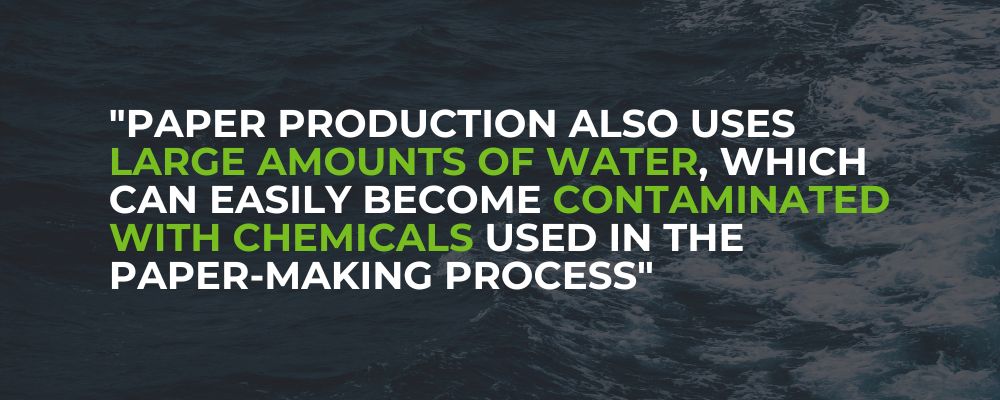
Global Warming
The paper we use in our everyday lives often goes overlooked as a source of pollution. But the paper we waste has a significant environmental impact, contributing to global warming and other environmental problems. Every year, billions of trees are cut down to make paper products. The paper industry is also one of the biggest users of water, polluting rivers and streams with chemicals used in the production process. And when paper is thrown away, it ends up in landfill where it releases methane gas, a powerful greenhouse gas. Recycling paper reduces the need to cut down trees and can help to reduce paper pollution. Sustainable forestry practices can also help to protect forests and wildlife habitats. By becoming more mindful of the paper we use, we can help to reduce its environmental impact.
Health Issues
One of the most significant environmental impacts of paper waste is the effect it has on our health. Paper mills release a number of harmful chemicals into the air, including sulfur dioxide, chlorine, and dioxins. These chemicals can cause respiratory problems, skin irritation, and cancer. In addition, paper recycling involves the use of large amounts of water and energy, which can lead to local water shortages and air pollution. Finally, paper products are often made from virgin tree fibre, which means that paper production is a major contributor to deforestation. As we become more aware of the environmental impact of paper waste, it is becoming increasingly important to recycle paper and choose sustainable paper products.
The paper industry is one of the biggest users of water and trees, two of our most important natural resources. Every year, millions of trees are cut down to make paper products, which often end up in landfills after just a single use. In addition, the paper-making process releases harmful chemicals into the environment. As a result, paper waste can have a significant impact on the environment. However, there are some things we can do to reduce this impact. By recycling paper products, we can decrease the demand for new paper and help to preserve our forests. In addition, using paper made from sustainable sources helps to ensure that these resources will be available for future generations. By making small changes in our paper usage, we can help to protect the environment.
The Business Impact Of Paper Waste

According to the EPA, an average office worker uses more than 10,000 sheets of copy paper each year. With the rise of digital communication, you would think that this number would be on the decline. However, a study by International Data Corporation found that paper consumption actually increased by 3% from 2014 to 2015. This increase is largely due to businesses that are still relying on paper documents for core functions such as invoicing, filing, and record-keeping.
Moving away from paper can save businesses money, improve efficiency, and help protect the environment. By investing in digital document management solutions, businesses can streamline their workflows and reduce their environmental impact.
Almost every business creates some level of paper waste, from the small business that prints a few receipts a day to the Fortune 500 Company that generates thousands of pages of documentation each week. While it's easy to overlook this type of waste, businesses can take steps to reduce their environmental impact and save money in the process. In this chapter, we'll discuss the business impacts of paper waste.

Higher Operational Costs
Paper waste can have a significant impact on businesses, both in terms of financial cost and operational efficiency. One of the most direct impacts is the higher cost of waste disposal. Paper waste is typically heavier and bulkier than other types of waste, which means that it costs more to transport and dispose of it. In addition, paper waste takes up valuable space in landfills, which can lead to higher rates for commercial dumping fees. Finally, the production of paper products requires energy and water, which can drive up operational costs. As a result, businesses need to be aware of the potentially dangerous impact of paper waste and take steps to reduce it.
Diminished Credibility
Paper waste can have a significant impact on businesses, both in terms of their bottom line and their credibility. One of the most obvious impacts is the cost of disposing of paper waste. Paper takes up a lot of space, and it can be expensive to store or dispose of it properly. In addition, paper waste can also lead to decreased productivity. When offices are cluttered with paper, it can be difficult to find what you need and stay organized. This can lead to lost documents, misplaced files, and frustrated employees. Finally, paper waste can also damage a company's reputation. Environmental consciousness is becoming increasingly important to consumers, and businesses that produce a lot of paper waste may be viewed as careless or irresponsible. This can lead to lost customers and decreased sales. In conclusion, paper waste can have serious business impacts, both in terms of costs and credibility. Businesses should take steps to reduce their paper use and ensure that any waste is disposed of properly.
Higher Risk Of A Security Breach
Paper waste is not only bad for the environment, but it can also pose a serious security risk to businesses. Paper documents can contain sensitive information that could be accessed by unauthorized individuals if they are not properly disposed of. In addition, businesses can be fined or subject to legal action if they are found to be violating the paper waste disposal regulations. As a result, it is essential for businesses to take all the necessary steps to reduce the amount of paper waste they generate and to ensure that all paper documents are properly shredded or destroyed before they are disposed of. By taking these precautions, businesses can help to protect themselves from the potentially devastating consequences of a security breach.
Increased Employee Stress
The business impacts of paper waste are far-reaching, and one of the most significant is the increased stress levels of employees. With the constant pressure to reduce costs and be more productive, employees are under a lot of performance stress and pressure. This can negatively affect employee health and well-being. In addition, paper waste can also lead to decreased morale and motivation levels, as well as increased absenteeism. All of these factors have a significantly negative impact on a company's bottom line. As such, it is essential for businesses to take steps to reduce paper waste and its associated business impacts.
Lower Productivity
As businesses increasingly strive to be more sustainable, the impact of paper waste has come under scrutiny. While it is true that paper recycling can help in terms of reducing the amount of waste accumulated in the landfills, it is also important to consider the negative impact of paper waste on business productivity. One study found that businesses lose an average of $85,000 per year as a result of paper waste. This is because paper waste can lead to lost documents, decreased office space, and reduced employee morale. In addition, paper waste can also have a negative environmental impact, as the production of paper requires large amounts of water and energy. As such, businesses should consider the impacts of paper waste when making decisions about their environmental policies.

Reduced Competitive Advantage
In today's business world, staying ahead of the competition is essential for success. Unfortunately, paper waste can have a negative impact on a company's competitive advantage. A reason for this is that paper waste can be a source of confidential information. If customer or client data falls into the hands of the wrong people, it could give competitors an advantage. In addition, paper waste takes up valuable storage space that could be used for inventory or other purposes. Finally, disposing of paper waste can be costly, which reduces profit margins and makes it more difficult to compete with other businesses. As a result, reducing paper waste should be a priority for any company looking to maintain a competitive edge.
Trimmings Are Created That Can Also Harm the Environment
Many industries create paper waste as a byproduct of their production process. While some companies recycle this paper waste, others simply dispose of it in landfills. However, both of these options can have a negative impact on the environment. Recycling paper waste requires energy and resources, and landfills can release harmful toxins into the ground and air. As a result, many companies are now exploring the option of using paper waste to create trimmings. These trimmings can be used in a variety of applications, including mulch, livestock bedding, and compost. Not only does this provide a more sustainable solution for the disposal of paper waste, but it can also help to reduce the legal impact of environmental regulations.
In conclusion, it is evident that paper waste has a significant negative impact on businesses and the environment. Paper waste can cause companies to lose money through decreased efficiency and increased costs, and it harms the environment by contributing to climate change and deforestation. There are many ways for businesses to reduce their paper waste, including recycling, using less paper, printing double-sided, and using electronic communication instead of paper. By implementing these solutions, businesses can help reduce the amount of damage caused by paper waste and improve their bottom line.
How To Reduce Paper Waste In The Office

Paper waste is one of the biggest environmental problems faced by businesses today. Not only does it take up valuable space in landfills, but it also requires significant resources to produce. The logging and pulping of trees release greenhouse gases into the atmosphere, contributing to climate change. Furthermore, the chemicals used in the paper-making process can pollute waterways and harm wildlife.
Reducing paper waste in the office is essential for protecting the environment. Simple steps like recycling used paper and using digital instead of paper communications can make a big difference. By reducing our reliance on paper, we can help to preserve forests, conserve water and energy, and reduce pollution. In other words, going paperless is good for business and good for the planet.
If you're looking for ways to reduce paper waste effectively in your office, you're not alone. Paper is one of the most commonly used materials in offices, and it can be difficult to cut back on its use. However, there are a few practices you can adapt to make a dent in your office's paper consumption.
Create a Paper Recycling Program
Although recycling programs have become more common in recent years, many office buildings still do not have a paper recycling program in place. This is particularly surprising given the amount of paper waste that offices generate on a daily basis. Not only does this create an environmental issue, but it also represents a significant cost for businesses. A paper recycling program is one way to help reduce paper waste in the office. By encouraging employees to recycle their used paper, businesses can make a positive impact on the environment and save money on waste disposal costs. There are a number of ways to set up a paper recycling program, and businesses should work with their local recycling facility to find the best solution for their needs. With a little effort, businesses can easily reduce their paper waste and make a positive contribution to the environment.
Use Recycled And Tree-Free Paper Products
One way to reduce paper waste in the office is by using recycled and tree-free paper products. Recycled paper is made from post-consumer waste, which means that it is made from paper that has already been used and reused. Tree-free paper, on the other hand, is made from alternative materials such as bamboo or sugar cane. Using recycled and tree-free paper products can help to reduce the amount of paper waste that ends up in landfills. Additionally, it is important to recycle used paper products so they can be turned into new paper products. Recycling helps to close the loop on paper production and consumption, making it a more sustainable way to use paper products.
Use Eco-Friendly Ink, Toner & Cleaning Products
The office is one of the most paper-intensive places. From daily printouts to important documents, it's no wonder that paper waste is a major problem. One way to reduce paper waste is to use eco-friendly ink, toner and cleaning products. These products are made from recycled materials and are designed to be less harmful to the environment. In addition, they often have fewer chemicals and fragrances, making them safer for office workers. Using eco-friendly products is a simple way to reduce paper waste and help protect the environment. And it's a good way to show your employees and customers that you care about creating a sustainable environment.

Stop Mailing Hard Copies of Documents
In today's digital age, there's really no need to waste paper by mailing hard copies of required documents back and forth. There are plenty of effective, eco-friendly alternatives that can save your business time and money. For instance, you can use electronic document signing services to securely sign and send documents without ever having to print them out. Or, you can set up a virtual filing system using a cloud-based storage service like Dropbox or Google Drive. Not only will this help you save paper, but it will also make it really easy to access your files from anywhere. So next time you're tempted to reach for the printer, consider one of these earth-friendly alternatives instead.
Opt for Electronic Billing and Statements
An easy way to reduce paper waste in your office is to opt for electronic billing and statements. Many businesses are already making the switch to paperless invoicing, and there are a number of benefits that come along with this. In addition to saving paper, electronic billing and statements can also save time and money. Sending invoices electronically is faster and more efficient than mailing them, and it eliminates the need for postage. Perhaps best of all, electronic billing and statements are good for the environment. Every year, billions of trees are cut down to produce paper, and the manufacturing of paper products is a major contributor to pollution. By switching to electronic billing and statements, businesses can help to protect the environment and reduce their carbon footprint.
Document Scanning
In today's business world, going paperless is more important than ever. Not only is it better for the environment, but it can also help to improve efficiency and cut costs. One way to reduce paper waste in the office is to implement document scanning. This process allows documents to be converted into digital files, which can be stored on a computer or cloud-based system. Not only does this free up space, but it also makes it convenient to search and retrieve files. In addition, secure document scanning can help to ensure that documents are properly indexed and archived. As a result, it is an integral part of any paperless office strategy.
Make Two-Sided Copies
In today's office environment, paper waste is a major issue. With so much emphasis placed on going green and being more environmentally friendly, it's important to find ways that can be useful to reduce paper waste in the office. A great way to execute this is by making two-sided copies. By printing on both the sides of the page, you can significantly reduce the amount of paper you use. Not only will this save you a decent sum of money on paper costs, but it will also help to reduce your environmental impact.
There are a few things to remember in terms of making two-sided copies. First, make sure that your printer is capable of printing on both sides of the page. Many newer printers have this capability, but some older models do not. Second, pay attention to the orientation of your pages. While printing on both sides of the page, you'll need to flip the pages over to print on the other side. Be sure to orient your pages correctly so that they print correctly on both sides. Finally, consider using recycled paper for your two-sided copies. This will further reduce your environmental impact and send a message to others that you're committed to being green.
Making two-sided copies is a simple way to reduce paper waste in the office. By following these tips, you can save money as well as help the environment at the same time.
So there you have it – some simple and easy ways to reduce paper waste in your office. All of these tips are simple and cost-effective, so there’s no reason not to give them a try. What are you waiting for? Start reducing that pile of paper on your desk today!

